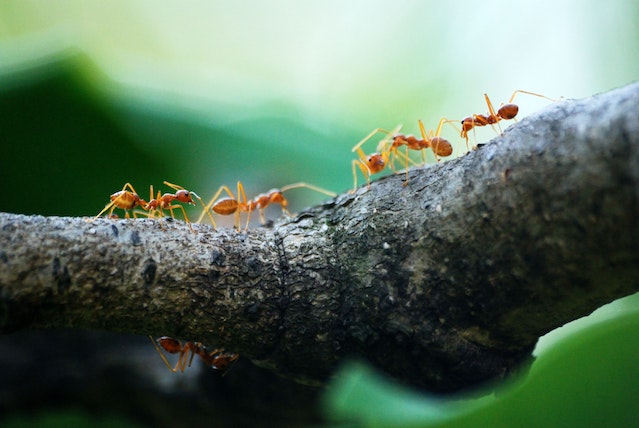
Are ants smart? They are not smart in the way that we are, but they have been observed using tools and performing tasks that would show they have some intelligence.
The size of an animal’s brain is not necessarily an indicator of how smart it is. If we just look at the largest brain, it is the blue whale’s brain, coming in at 7 kg, but the blue whale is not 7 times smarter than an animal whose brain weighs 1 kg, such as a giraffe (800 g or thereabouts). A blue whale’s brain only makes up 1% of its body mass, but brain to body mass is also not necessarily a good indicator of intelligence. An ant’s brain weighs approximately 0.3 mg, which is about 17% of the ant’s body mass.
Ants have very interesting brains. For their size, they have a lot of neurons. Most ants have 250,000 neurons. Their brains are also broken up into sections called ganglia. In our bodies, our brain is responsible for most of our actions, but we also have groups of nerves that are capable of making decisions without involving the brain. Without these, our reflexes wouldn’t work, and our brains would be constantly overtaxed. Ants have a similar process, but they have more of these groups of nerves than we do. These bundles of nerves are called ganglia and ants have them spread throughout their bodies. One ganglion is responsible for moving the legs, one for moving the wings, one for the antennae, and so on. By delegating the tasks, the ant’s brain can be so much smaller because it has less to do. Ant brains are small, but ants work in colonies and possibly have access to a hive mind. Single ants behave like neurons in our brains. They search for information and process information that can be used by the whole hive to make decisions.
So, what do ants do that is smart? They can navigate, they can show other ants where food is, they can avoid obstacles, they can teach other ants, they can work in a group, and they can farm food.
Ants appear to walk in a haphazard fashion across any terrain when they are looking for food, but they are actually navigating and they are always aware of where their nest is. They use the position of the sun, light patterns, visual objects, odors, wind direction, gradient of the ground, texture of the ground, and even counting their steps to know where they are. They always keep a direct route back to their nest in their minds and should they get lost, they have methods to look for the hive. Their method of walking may appear haphazard, but it allows them to cover the most ground in the search for food.
When ants find food, and if it is too much for them to carry back to the nest, they bring back what they can and mark the trail using pheromones. When they get to the nest, they can communicate to the other ants that they have found food and ants will head out along the pheromone trail to find the food. If you drop a stick on this pheromone trail, breaking it up, the ants will start heading out in random directions until one of them makes contact with the pheromone trail again and that ant will then leave a new trail that goes round the sticks. It seems random, but because so many ants are shooting out in different directions, the chances are high that one of them will find the trail again. It is very much in the same way that our brains work.
Ants are also able to teach their skills to younger ants. Some species of ants teach younger ants through tandem running. A more experienced ant will head out with a younger ant, and it will show the younger ant where food sources are and where certain landmarks are. The younger ant will pause every now and again to memorize a part of the route and the experienced ant will wait. When the younger ant is ready, it will tap on the rear legs and the abdomen of the teacher to show that it is ready and the teacher will carry on. If the teacher gets too far ahead of the pupil it will slow down and wait. This demonstrates the hive mind at work. If the teacher ant went out on its own, it would reach the food four times faster than when it goes with a student. However, by teaching another ant, the teacher is ensuring that in the long run more food will reach the hive.
And, possibly the most famous example: some ants farm their own food. Some leafcutter ants farm fungus to feed to their larvae. They bring back leaves into the nest and then chew them up to feed to a fungus that they allow to grow in certain areas of their nest. They feed the fungus and in turn, use it as a food source for their larvae. There are other ants that farm aphids. They keep the aphids in certain areas on plants and they feed on a sugary liquid that the aphids produce. The ants herd the aphids and their eggs into areas that are hidden under leaves, keeping them out of the site of predators. The aphids get to stay alive and the ants get the sugary liquid. It is win win for both species, although the aphids don’t seem to appreciate it and the ants have to put in quite a lot of work to keep them safe.
So, ants are far smarter than we would think for the size of their brain. And this is what I learned today.
Photo by Poranimm Athithawatthee: https://www.pexels.com/photo/macro-photo-of-five-orange-ants-842401/
Sources
https://www.heartspm.com/farming-aphids-herder-ants-a-k-a-farmer-ants.php
https://time.com/118633/ant-intelligence-google/
https://www.bristol.ac.uk/news/2006/879.html
https://mindmatters.ai/2022/06/the-hive-mind-leafcutter-ants-behave-like-farmhands-but/
https://meadowia.com/do-ants-have-brains/
https://www.smorescience.com/do-ants-have-brains/
https://www.sciencedirect.com/science/article/pii/S0959438821001021
https://www.scientificamerican.com/article/weve-been-looking-at-ant-intelligence-the-wrong-way/
https://www.kiwicare.co.nz/advice/pests/how-smart-are-ants/
https://scienceinpoland.pl/en/news/news%2C409288%2Csmall-ants-and-their-big-brains.html
